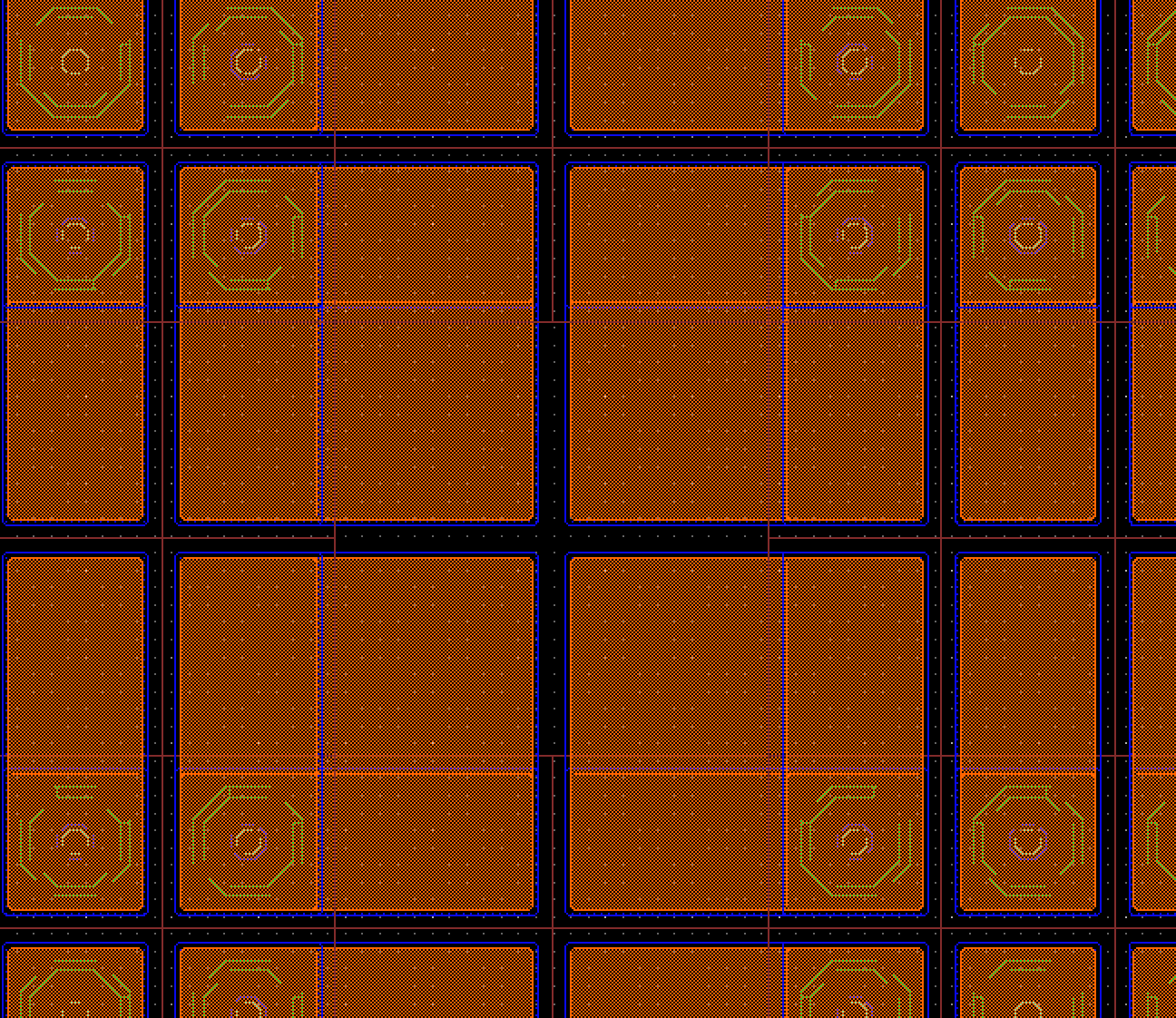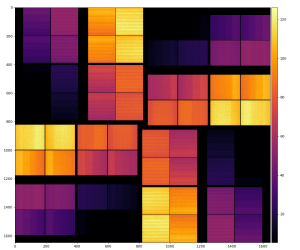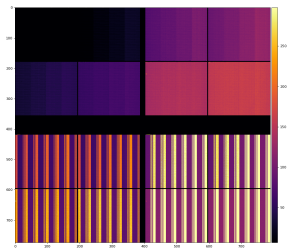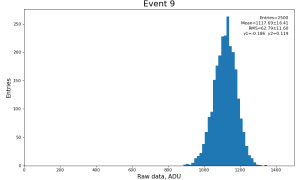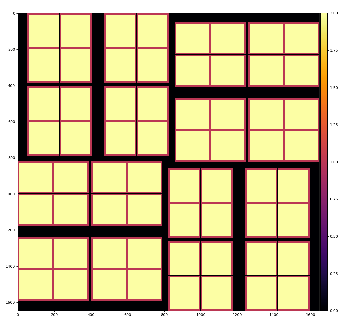Two new detectors EPIX10KA2M and EPIX10KAQUAD are composed from EPIX10KA modules.
Content
Geometry
Plots and comments from Chris Kenny
Kenney, Christopher J. 2018-11-12, 2:26 PM Guide tube is 7mm outer diameter We added polyimide tape that was 150 microns thick before application to the tube. But a decent estimate would be the mechanical edge-to-edge orthogonal separation between sensor edges 7.3 mm. We need to add about 1 mm for the guard rings on each sensor So the orthogonal gap between active pixels on opposing quads across the beam guide tube should be 8.3 mm ==== Kenney, Christopher J. 2018-11-12, 4:41 PM Blaj, Gabriel;Dubrovin, Mikhail;Kwiatkowski, Maciej Very rough estimate of the gaps There are 3 types of gaps All are active pixel to active pixel sensor to sensor ~ 1.6 mm CB to CB ~ 6.4 mm sensor to CB ~ 3.9 mm ==== CB = Carrier Board edges Full camera image below ==== so 384 columns parallel to the balcony (the widest dead gaps) and 352 orthogonal to the balcony (vertical direction)
epix10ka2m assembly
epix10ka2m-insensitive-gaps.pdf
epix10ka sensor central region between 4 ASICs
The internal gap between four ASICs in sensor,
pixel size 100 x 225 microns in area in both directions.
Metrology map from Chris Kenney
- 2018-11-18-epix10ka2m-metrology-map.pdf
- 2018-11-18-epix10ka2m-metrology-map.pptx
- 2018-11-15-Metrology-epix10ka2m.xlsx
Comments on orientation of epix10ka2m parts from Matt
Weaver, Matt 2018-11-19, 7:37 PMO'Grady, Paul Christopher;Dubrovin, Mikhail Hi Mikhail, We took radioactive source test runs today to verify the geometry. We found that we were rotated by 90 degrees, which matches the labeling on the back of the detector as well as the metrology picture from Chris Kenney. The runs are /reg/d/psdm/det/detdaq17/e968-r0131 - source unmasked (up to ~ event 10000), then masked vertically after ~ event 15000 /reg/d/psdm/det/detdaq17/e968-r0132 - source masked horizontally at bottom after ~ event 15000. So, the picture is... // (Epix10ka2m) // | // Quad 0 | Quad 1 Quad 2 is rotated 90d clockwise // -------+-------- Quad 3 is rotated 180d clockwise // Quad 3 | Quad 2 Quad 0 is rotated 270d clockwise // | // // (Quad 1) // | // Elem 0 | Elem 1 // -------+-------- No rotations // Elem 2 | Elem 3 // | // // (Elem 0) // | // ASIC 0 | ASIC 3 // -------+-------- No rotations // ASIC 1 | ASIC 2 // | // // (Elem 0-3 pixel array) // row increasing // ^ // | // | // column increasing <-- (0,0)
Preliminary geometry
in /reg/g/psdm/detector/data_test/calib/
/reg/g/psdm/detector/data_test/calib/Epix10ka2M::CalibV1/NoDetector.0:Epix10ka2M.0/geometry/0-end.data @ (epix10ka2m - entire detector) /reg/g/psdm/detector/data_test/calib/Epix10kaQuad::CalibV1/NoDetector.0:Epix10kaQuad.0/geometry/0-end.data @ (epix10kaquad - one quad) /reg/g/psdm/detector/data_test/calib/Epix10ka::CalibV1/MecTargetChamber.0:Epix10ka.1/geometry/0-end.data @ (epix10ka - one panel)
copy of geometry files in alignment examples /reg/g/psdm/detector/alignment/
/reg/g/psdm/detector/alignment/epix10ka2m/calib/Epix10ka2M::CalibV1/NoDetector.0:Epix10ka2M.0/geometry/0-end.data /reg/g/psdm/detector/alignment/epix10kaquad/calib/Epix10kaQuad::CalibV1/NoDetector.0:Epix10kaQuad.0/geometry/0-end.data /reg/g/psdm/detector/alignment/epix10ka/calib/Epix10ka::CalibV1/MecTargetChamber.0:Epix10ka.1/geometry/0-end.data
Gain
Gain factors from charge injection default and measured
| gain | charge injection | current default | measured (ADU / keV) |
|---|---|---|---|
| L | 0.46 | 0.01 | 0.139 |
| M | 15. | 0.3(3) | 4.5 |
| H | 46.7 | 1 | 13.9 |
Gain factors default vs charge injection
- Detector/examples/ex_epix10ka_images.py
- XcsEndstation.0:Epix10ka2M.0
- charge injection gain factors were generated from exp=xcsx35617:run=544
- data with water ring for comparison exp=xcsx35617:run=528
- account relative factor 46.7
- selected rect [6, 120:170, 200:250]
gain default: H / M / L = 1 / 0.33333 / 0.01
gain from charge injection:
| constants | Mean | RMS | RMS / MEAN |
|---|---|---|---|
| default | 1117.7 | 62.72 | 0.05618 |
| charge injection | 1177.5 | 66.79 | 0.05672 |
Conclusion: in this test charge injection gainci constants do not improve gain factors comparing to default
Masks
mask_geo
mask_geo = det.mask_geo(par, mbits=3, width=10, wcentral=5)
- mbits = 1 - masks edges, +2 - masks central rows and columns.
- width - number of edge rows or columns to mask, def=1
- wcentral - number of central rows or columns to mask, def=1
plot for mask_geo + 1:
status_as_mask
- use pixel_status for exp=xcsx35617:run=544
- mask_status = det.status_as_mask(par, mode=0, indexes=(0,1,2,3,4))
- mode 0/1/2 masks zero/four/eight neighbors around each bad pixel
- indexes=(0,1,2,3,4) # indexes stand for 'FH','FM','FL','AHL-H','AML-M', respectively. Derived modes have the same status arrays.
found number of bad pixels
- 2802 for F gain modes and
- 3253 for all F + A modes
plots for mask_status + 1 for mode=0 and 3:
References
mask_geo = det.mask_geo(par, mbits=3, width=10, wcentral=5)wcentralmode 0/1/2 masks zero/four/eight neighbors around each bad pixelindexes=(0,1,2)) # indexes=(0,1,2,3,4)


